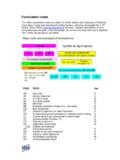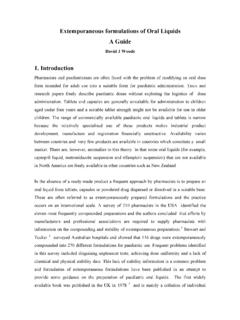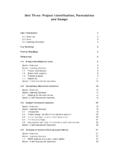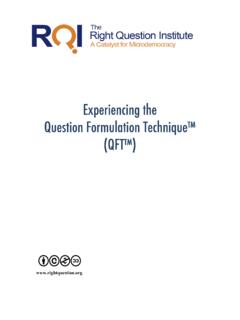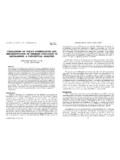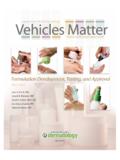Transcription of The International Association for the Properties of …
1 IAPWS R12-08. The International Association for the Properties of water and Steam Berlin, Germany September 2008. Release on the IAPWS formulation 2008 for the viscosity of ordinary water Substance 2008 International Association for the Properties of water and Steam Publication in whole or in part is allowed in all countries provided that attribution is given to the International Association for the Properties of water and Steam President: J. R. Cooper School of Engineering and Materials Science Queen Mary, University of London Mile End Road London E1 4NS, England Executive Secretary: Dr. R. B. Dooley Structural Integrity Associates, Inc.
2 2904 South Sheridan Way, Suite 303. Oakville, Ontario, L6J 7L7, Canada email: This release contains 9 pages, including this cover page. This release has been authorized by the International Association for the Properties of water and Steam (IAPWS) at its meeting in Berlin, Germany, 7-12 September 2008, for issue by its Secretariat. The members of IAPWS are: Argentina and Brazil, Britain and Ireland, Canada, the Czech Republic, Denmark, France, Germany, Greece, Italy, Japan, Russia, the United States of America, and associate member Switzerland. This release replaces the Revised Release on the IAPS formulation 1985 for the viscosity of ordinary water Substance, issued in 2003.
3 Further information concerning this release and other documents issued by IAPWS can be obtained from the Executive Secretary of IAPWS or from 2. Contents 1. Introductory Remarks 2. 2. Recommended Correlating Equation 2. Nomenclature 2. Reference constants 2. Dimensionless variables 3. Range of validity 3. Estimated uncertainty 4. Correlating equation 4. Critical enhancement 6. Simplified use outside the critical region 8. 3. Recommendation for Industrial Application 8. 4. Computer-Program Verification 8. 5. References 9. 1. Introductory Remarks This release provides a correlating equation for the shear viscosity of pure water substance over an extensive range of fluid states.
4 A discussion of the background, development, and validation of this formulation is presented in Ref. [1]. Section 2 of this release contains the correlating equation, necessary constants, range of validity of the equation, and estimates of the uncertainty of the correlation. Section 3. concerns the industrial application of the viscosity correlation, and Section 4 presents selected values of the correlation at specific state points to enable computer verification of an implementation of the correlation. 2. Recommended Correlating Equation Nomenclature T denotes absolute temperature on the International Temperature Scale of 1990. denotes density p denotes pressure denotes viscosity Reference constants The reference constants used in this formulation for temperature, pressure, and density agree with presently accepted values of the critical temperature, pressure, and density of water recommended by IAPWS [2], while the reference constant for viscosity has no physical significance.
5 3. reference temperature: T* = K (1). reference density: * = kg m 3 (2). reference pressure: p* = MPa (3). reference viscosity : * = 10 6 Pa s (4). Dimensionless variables temperature: T = T/T* (5). density: = / * (6). pressure: p = p/p* (7). viscosity : = / * (8). Range of validity Equation (10) below is recommended for computation of the viscosity for all thermodynamically stable fluid states in the following ranges of pressure p and temperature T: 0 < p < pt and K T K. pt p 300 MPa and Tm(p) T K. 300 MPa < p 350 MPa and Tm(p) T K (9). 350 MPa < p 500 MPa and Tm(p) T K. 500 MPa < p 1000 MPa and Tm(p) T K. In Eq. (9), Tm is the pressure-dependent melting temperature and pt is the triple-point pressure as given in Refs.
6 [3,4]. For most applications, the IAPWS formulation 1995 for the Thermodynamic Properties of ordinary water Substance for General and Scientific Use [5,6]. should be used to determine the densities used as input to Eq. (10), when the state point under consideration is defined by pressure and temperature or by other thermodynamic variables instead of density and temperature. In addition, IAPWS makes the following statements about extrapolation of Eq. (10) outside the range of validity given above: For vapor states at temperatures below the triple-point temperature of K and pressures less than or equal to the sublimation pressure, the viscosity calculation is dominated by the dilute-gas term, and this behaves in a physically reasonable manner down to at least 250 K.
7 For stable fluid states outside the range of validity of Eq. (10) but within the range of validity of the IAPWS formulation 1995 for the Thermodynamic Properties of ordinary water Substance for General and Scientific Use [5,6], the extrapolation behavior of Eq. (10) is physically reasonable. At high temperatures, the extrapolation of the dilute-gas portion of Eq. (10) is physically reasonable up to at least 2500 K. For the metastable subcooled liquid at atmospheric pressure, Eq. (10) is in fair agreement (within 5 %) with available data down to 250 K. 4. Estimated uncertainty The uncertainties in this formulation are summarized in Figure 1; they can be considered as estimates of a combined expanded uncertainty with a coverage factor of two.
8 Thus the viscosity at any state point can be expressed as where is the applicable value in Figure 1. The formulation reproduces the ISO recommended value of the viscosity at 20 oC. ( K) and standard atmospheric pressure within the number of digits given in Ref. [7]; it also agrees with all values from to K at atmospheric pressure in Ref. [7] within the stated uncertainty of % at K. Figure 1. Estimated uncertainty of the correlating equation. Correlating equation The viscosity is represented by the equation = 0 (T ) 1 (T , ) 2 (T , ) . (10). The first factor 0 of the product represents the viscosity in the dilute-gas limit and is given by 5.
9 100 T. 0 (T ) =. 3. , (11). Hi . i =0 T. i with coefficients Hi given in Table 1. Table 1. Coefficients Hi for 0 (T ). i Hi 0 1 2 3 The second factor 1 represents the contribution to viscosity due to finite density: 1. 5 i 6 . 1 (T , ) = exp 1 H ij ( 1) j , (12). i =0 T j =0 . with coefficients Hij given in Table 2. The third factor 2 represents the critical enhancement of the viscosity . Table 2. Coefficients Hij for 1 (T , ). i j Hij 0 0 10 1. 1 0 10 2. 2 0 3 0 10 1. 0 1 10 1. 1 1 10 1. 2 1 3 1 5 1 10 1. 0 2 10 1. 1 2 10 1. 2 2 10 1. 3 2 10 1. 4 2 10 1. 0 3 10 1. 1 3 10 1. 0 4 10 2. 3 4 10 2. 4 5 10 3. 3 6 10 3. 5 6 10 4. Note: Coefficients Hij omitted from Table 2 are identically equal to zero.
10 6. Critical enhancement The critical enhancement is only significant in a very small region in density and temperature around the critical point. Although exactly at the critical point the viscosity is infinite, the enhancement term contributes an amount greater than 2 % of the full viscosity only within the following boundaries: K < T < K, kg m 3 < < kg m 3 . (13). Thus, the critical enhancement is significant only within the boundaries specified by Eq. (13);. outside this region, the enhancement is always less than the uncertainty in the formulation . This allows simplification for certain calculations (see Sections and 3). The function 2 is defined over the entire range of states by: 2 = exp(x Y ) , (14).



